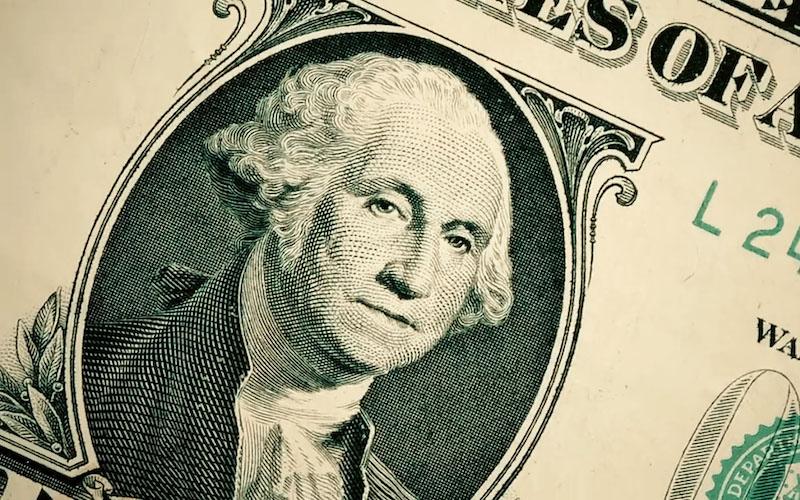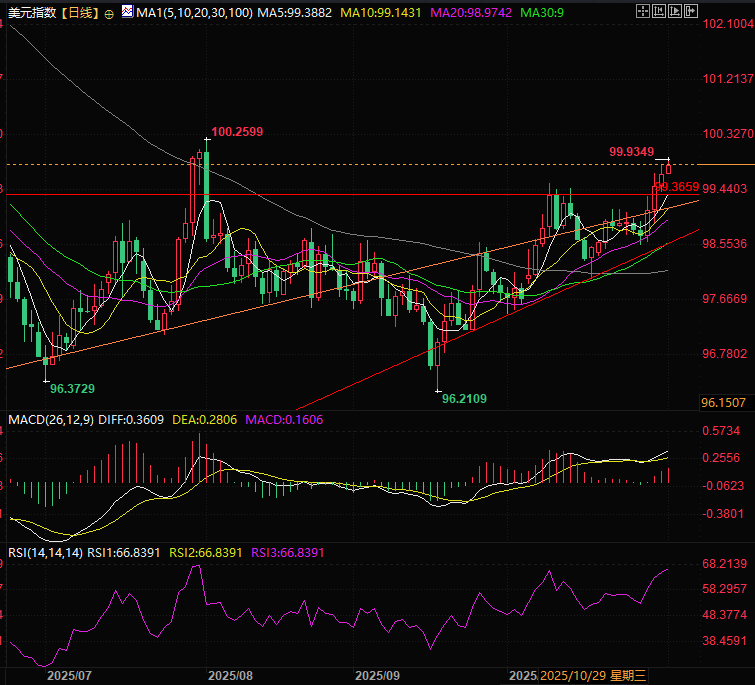A Wall Street conspiracy has been exposed, and the dollar's 100-point level may be a bull trap.
2025-11-03 20:39:34
The US dollar index has recently found buying support below the psychological level of 100.00. As a core indicator for measuring the strength of the dollar against a basket of currencies, the index has risen by more than 1% since the Federal Reserve's October monetary policy meeting and is currently trading around 99.88, showing a slightly bullish trend.

This article briefly describes the short-term trend and support logic of the US dollar index: analysis of policies, data and institutional views.
The Federal Reserve's hawkish signals have taken effect, significantly cooling expectations for a December rate cut.
The Federal Reserve announced a 25-basis-point cut in the benchmark interest rate at its October monetary policy meeting as expected, which was in line with market expectations. However, Fed Chairman Jerome Powell's remarks exceeded market expectations.
He explicitly emphasized that, given the current backdrop of rising inflation and a stagnant labor market, monetary policy formulation faces multiple challenges. He also warned the market against having overly high expectations for further easing this year, directly suppressing market bets on easing.
This hawkish signal continues to provide momentum for the US dollar. According to data from the CME FedWatch Tool, investors' bets on a December rate cut have fallen sharply from 91% before the meeting to 67%, further supporting the dollar's performance as expectations for easing cool.

(CMEFedWatch interest rate futures trend)
US economic data is a key variable, with manufacturing PMI and employment data attracting attention.
The market's current focus is on economic data, and the performance of this data may become a key catalyst for the short-term trend of the US dollar.
On Monday, the market focused on the US October manufacturing activity data: the market expects the S&P Global Manufacturing Purchasing Managers' Index (PMI) to show improvement, with the October reading expected to rise to 52.2 from 52.0 in September, continuing the expansion range;
The US Institute for Supply Management (ISM) Manufacturing PMI is expected to remain in contraction territory, from 49.1 to 49.5 in September, still below the 50-point mark separating expansion from contraction.
It is worth noting that the price sub-index of the ISM Manufacturing PMI is expected to rise to 62.6 from the previous 61.9. This signal indicates that inflationary pressures in the manufacturing sector are marginally increasing, which may further reinforce the legitimacy of the Fed's hawkish stance.
In addition, subsequent data is equally crucial: it is still uncertain whether JOLTS job openings data will be released, but the monthly ADP employment report released on Wednesday is considered to be the biggest opportunity for the dollar's downward trend to resume this week, and the market will pay close attention to the signals sent by the private sector data.
Institutional Information: Two major factors support the US dollar; the index may fluctuate within a high range.
Regarding the current trend of the US dollar, Chris Turner, a foreign exchange analyst at ING Group, pointed out that after the US and China reached a one-year trade truce agreement last week, risk currencies did not see the expected boost, while the US dollar remained the dominant topic in the market, mainly due to two supporting factors.
First, the market is reassessing the extent of the Federal Reserve's easing cycle. The probability of a 25 basis point rate cut in December has now fallen to 66%, and may decline further depending on this week's US data, with private sector data carrying significant implications.
Second, the tense situation in the US money market supported dollar buying.
Since the beginning of this year, the Federal Reserve has reduced bank reserves through quantitative tightening, while the U.S. Treasury has increased its general account cash reserves from $300 billion to $950 billion, leading to a tighter money market environment. Data released last Friday showed that banks obtained $50 billion in overnight funding from the Federal Reserve's Standing Repo Facility, paying an interest rate of 4.00% (theoretically, market interest rates should be in the middle of the Federal Reserve's 3.75%-4.00% policy rate range).
ING further predicts that if the difficulty in obtaining dollar funding does not extend to the international market's cross-border currency basis swap sector (there are currently no signs of this), the dollar index will fluctuate near the three-month high, i.e., in the 100.00/100.25 range, unless US employment market data prompts the market to re-price the probability of a December Fed rate cut at 100%.
Summary + Technical Analysis
The US interbank reserve ratio is at a historical low, providing clear short-term support for the US dollar. However, this is merely a monetary phenomenon. When the US dollar index reaches around 100, a short squeeze may occur, but without substantial positive news, it could lead to a rapid correction. Traders need to be wary of the risk of being squeezed out and should avoid chasing highs.
The US dollar index broke out of an ascending wedge pattern, with the measured increase around 100.50. Both MACD and KDJ indicators show a healthy upward trend in the US dollar index, with no divergence observed.
Resistance is at the previous high of 100.25 and the psychological level of 100, while support is around 99.36, which is the 50% retracement level of the bearish candlestick released on August 1st.

(US Dollar Index Daily Chart, Source: FX678)
At 20:32 Beijing time, the US dollar index is currently at 99.85.
- Risk Warning and Disclaimer
- The market involves risk, and trading may not be suitable for all investors. This article is for reference only and does not constitute personal investment advice, nor does it take into account certain users’ specific investment objectives, financial situation, or other needs. Any investment decisions made based on this information are at your own risk.





















